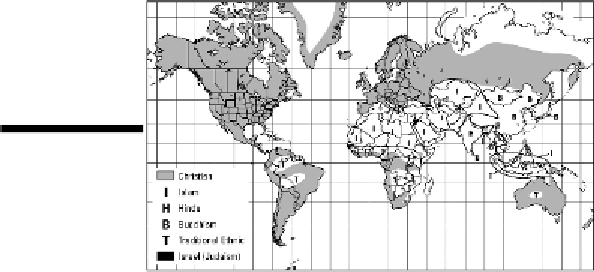Geography Reference
In-Depth Information
Creating local character
Inexercisingtheirfaiths,humansoftenimpartreligiouscharactertothelandstheyoccupy.Thenature
oftheseimpactsvaryfromcreatingculturallandscapestomakingpsychologicalattachments toplace,
andfromperforming acts ofsolemnity tocommitting acts ofbloodshed.Herearefourwaysadherents
imbue locations with religious characteristics.
Places of worship
Practitioners of some religions build houses of worship that are magnificent works of architecture
and, quite literally, outstanding components of the cultural landscape. Until fairly recent times, the
spires of churches, towers of mosques, and domes of temples, dominated skylines. Indeed, in many
smaller towns and some cities worldwide, they still do.
Figure 13-3:
Predomi-nant re-
ligious groups
around the world.
While the essence of place is usually captured in things that are seen, it may also be echoed in things
that are heard. Thus, some cultural geographers speak of “the audible landscape.” That may sound a
bit cryptic, but if you have ever heard church bells reverberate through a valley, or heard the Islamic
call to prayer ring out from aminaret, then you have experienced the power of sound as a cultural
geographic characteristic.
Sacred sites
Most religions recognize sites that have special significance in the minds of believers. These may
serve as destinations of pilgrimage (such as Mecca and Lourdes), places of great historical religious
significance (the Wailing Wall), or places where a solemn ritual is to be performed (Benares or the
Via Dolorosa). The bond between religion and sacred site may be so strong as to create an uncom-


